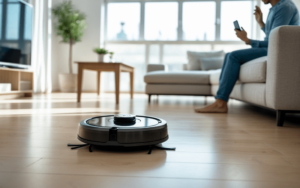Imagine waking up feeling more refreshed and energized, all thanks to the right kind of light. Smart lighting for wellness can transform your home’s atmosphere, helping you sleep better and improve your mood. By understanding how circadian rhythms work, you can use smart bulbs to simulate natural light patterns that promote restful sleep and reduce stress.
Many people don’t realize how much the type of lighting affects their mood and well-being. With advances in technology, using smart lighting to create the best circadian lighting for sleep is more accessible than ever. These solutions include color-changing bulbs that mimic sunlight, providing light therapy for stress relief and helping you maintain a healthy light environment.
For homeowners wanting to make simple yet effective changes, selecting the right smart lighting solutions is key. Whether it’s setting up routines that align with natural daylight cycles or choosing smart bulbs for better sleep, the impact can be significant.
Please note that this article contains affiliate links. As an Amazon Associate, we earn from qualifying purchases at no extra cost to you.
Key Takeaways
- Smart lighting enhances sleep and mood.
- Choosing the right circadian lighting is crucial.
- Smart bulbs provide stress-relieving light therapy.
Understanding Circadian Rhythms

Circadian rhythms are natural cycles that affect sleep and alertness throughout the day. Light exposure plays a significant role, influencing hormones and impacting health and well-being. Understanding how these rhythms work is essential for improving sleep and mood.
The Science of Sleep
Circadian rhythms are 24-hour cycles governed by an area in the brain called the suprachiasmatic nucleus. This biological clock regulates sleep-wake patterns, body temperature, and various hormonal changes. It operates through signals triggered by light and darkness.
During daylight, these rhythms keep people alert and active. With the onset of darkness, the brain sends signals that promote sleep. Disruptions, like traveling across time zones or improper light exposure, can lead to sleep disturbances and fatigue. Smart lighting can aid in syncing these rhythms with day and night cycles, ensuring better rest.
Light and Melatonin Production
Light exposure greatly influences melatonin, the hormone responsible for sleep regulation. When light enters the eyes, it signals the brain to reduce melatonin production, which keeps people awake. Conversely, as darkness approaches, melatonin levels rise, prompting sleep.
Modern technology often disrupts this natural process. Bright screens and artificial lighting at night can trick the brain into thinking it’s still daytime. Adjusting light exposure can help maintain healthy melatonin levels. Integrating circadian lighting strategies can improve this hormonal balance, enhancing sleep quality and mood. For more ideas, explore circadian lighting hacks designed to support healthy rhythms.
The Impact of Lighting on Mood

Lighting can greatly affect an individual’s mood and emotions. Bright and natural light are known to improve mood by boosting serotonin levels. Different lighting settings can also play a role in how people feel, making understanding these effects crucial.
Psychology of Lighting
Lighting influences how people perceive their surroundings and themselves. Bright light often makes individuals feel more energetic and alert. Exposure to natural light has been linked to improved mood and increased productivity. Research shows that it can even regulate emotions, leading to a balanced state of mind.
In contrast, dim lighting creates a calming effect and is less stimulating, which can help with relaxation. The psychology behind lighting also suggests that certain light qualities can intensify emotions, making the choice of lighting essential in spaces where mood regulation is important.
We may earn a small commission if you purchase through this link. Thank you for supporting our content!
Color Temperature and Emotion
Color temperature refers to the warmth or coolness of light. It is measured in Kelvin (K). Warm light, like incandescent bulbs, has a lower Kelvin value and creates a cozy atmosphere. This type of lighting is effective for unwinding or socializing as it promotes calmness.
On the other hand, cool lighting exhibits higher Kelvin values and is often found in office settings. It sharpens focus, enhancing alertness and productivity. Cool lighting might be useful for tasks that require attention and precision, while warm lighting suits settings for relaxation or socialization. Different environments can greatly benefit from the strategic choice of color temperature.
Selecting Smart Lighting Solutions

Smart lighting can improve sleep and mood. The right lighting solutions can suit different needs, helping regulate circadian rhythms and create a more pleasant environment.
Types of Smart Lights
Smart bulbs and strips are among the most popular options. These lights can change color and brightness using apps or voice commands.
Smart bulbs like Philips Hue and LIFX are easy to install. They replace standard bulbs and offer a wide range of colors and tones.
LED strips are flexible and can be used to accent furniture or provide indirect lighting. Smart plugs are another option. They allow any lamp to be controlled remotely.
Each type of smart light has its own benefits. Choosing the right one depends on the user’s specific goals and needs.
We may earn a small commission if you purchase through this link. Thank you for supporting our content!
Features to Consider
When selecting smart lights, consider compatibility with existing devices. Many smart lights work with systems like Google Assistant, Amazon Alexa, or Apple HomeKit.
Energy efficiency is also important. Look for LED options, which consume less power and last longer than traditional bulbs.
Automation features, such as scheduling and motion detection, provide convenience and energy savings.
Another feature to consider is color temperature control. This feature allows users to adjust the lights to mimic natural daylight. This can help regulate sleep cycles and improve mood.
Setting Up Your Smart Lighting for Wellness
Smart lighting can significantly improve sleep and enhance mood when set up effectively. Proper adjustment of light intensity and color can help align sleep patterns and create a relaxing atmosphere.
Optimizing Light for Sleep
Setting smart lights to mimic natural daylight can help regulate sleep cycles. In the morning, bright and cool light can signal the mind to wake up. Sunrise simulation is an effective feature found in various smart lighting systems that smoothens the transition from sleep to wakefulness by gradually increasing light intensity. In the evening, warmer tones help prepare the body for rest. Brands like Philips Hue and LIFX offer customizable options to adjust light color and brightness accordingly.
Automations are crucial for maintaining a consistent sleep schedule. Lights can be programmed to dim at specific times, reducing exposure to blue light, which can interfere with melatonin production and sleep quality. Circadian lighting improves well-being by making these adjustments easier.
Creating a Mood-Enhancing Environment
Smart lighting can transform a living space by changing the atmosphere instantly. Users can easily switch from an energizing daytime setting to a cozy, relaxing evening scene. Various preset themes are available that adjust brightness and color to suit different moods.
Customizing light settings for specific activities, like reading or relaxing, can improve the experience. Scheduling lights to change based on the time of day or activity is also helpful. Automations play a key role in effortlessly setting the right mood without manual adjustments. By creating different lighting scenes, spaces can be welcoming and comfortable.
Maintaining Healthy Light Habits
Healthy light habits involve setting routines that align with natural light cycles and using technology to enhance wellness. Adjusting lighting routines and incorporating smart devices can improve sleep patterns and mood.
Routine Adjustments
Adjusting light exposure can significantly impact health. It’s important to mimic natural daylight patterns indoors. During the day, increasing light exposure can enhance energy levels. In the evening, reducing light can signal the body to wind down, promoting better sleep.
Using dimmable smart lights allows control over brightness levels throughout the day. Morning settings with bright, cool light can energize people, while evening settings with warm, dim light help relax. Consistent light patterns reinforce the body’s internal clock, reducing sleep disturbances and improving overall mood.
Wellness Technology Integration
Smart lighting technology offers personalized control over the lighting environment. Integrating smart bulbs and devices can support health goals. For instance, using smart bulbs with color-changing features can adjust light color to match activities, aiding relaxation or alertness as needed.
Systems like human centric lighting mimic natural light, supporting the body’s circadian rhythms. These systems encourage productivity and well-being by aligning indoor light with natural sunlight patterns. Voice-controlled devices make it easy to adjust lighting settings hands-free, making wellness technology more accessible and user-friendly.
Frequently Asked Questions
Smart lighting offers numerous benefits for enhancing sleep and mood by adjusting brightness, color, and timing. These systems can be synced with other smart home devices to create a personalized wellness environment.
How does smart lighting contribute to better sleep quality?
Smart lighting can simulate natural light patterns, mimicking sunrise and sunset. This helps regulate the body’s internal clock, leading to improved sleep quality. By gradually increasing light in the morning, it helps you wake up more easily.
What are the optimal settings for smart lights to enhance mood?
The best settings for mood enhancement involve using natural light simulations during the day. Warm, dim lighting in the evening can aid relaxation. Adjustable settings allow users to personalize environments according to their needs, promoting an overall sense of well-being.
Can the use of specific lighting colors reduce stress and improve wellness?
Yes, certain colors like blue and green can have calming effects, helping to reduce stress. Warm colors, such as soft reds or oranges, can create a cozy atmosphere. These lighting options can contribute to an improved state of relaxation and mental wellness.
What are the benefits of wellness lighting in a home environment?
Wellness lighting can improve mood regulation and provide a more relaxing environment. Exposure to natural light can enhance overall mood and lead to better sleep. This contributes to an increased sense of relaxation and happiness.
How can smart lighting be integrated with other home automation systems for wellness?
Smart lighting can be integrated with home automation systems by syncing with devices like thermostats, noise machines, and smart blinds. This allows for the creation of a seamless wellness system, enhancing comfort and relaxation. Systems can be managed through apps or voice commands for convenience.
What are the best practices for configuring smart lighting for a healthier living space?
To set up smart lighting effectively, start with a gradual light schedule that mimics natural light. Use appropriate color settings based on time of day to support circadian rhythms. Regular updates and adjustments can optimize how lighting supports daily wellness routines and improves living conditions.
This article contains affiliate links, which means we may earn a commission if you purchase through our links, at no extra cost to you. As an Amazon Associate, we earn from qualifying purchases. Thank you for supporting our content!




